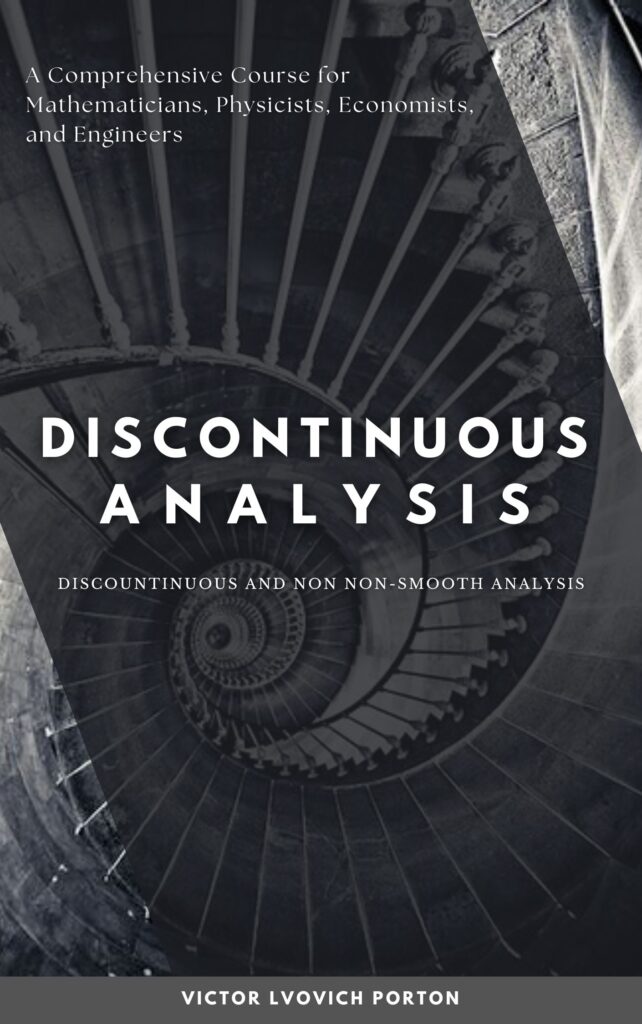
Discontinuous Analysis
Mastering Discontinuous Analysis: A Comprehensive Course for Mathematicians, Physicists, Economists, and Engineers
No limit of an arbitrary function? No root of -1? There is indeed a root of -1 and likewise there is a (generalized) limit of every function at every point, for all types of discontinuity in calculus. Learn to use it in practice for limits, sums, derivatives, integrals of arbitrary functions.
Available On



Full text is available for free, but free version has bad typography, inconvenient to read.
For whom is discontinuous analysis?
In Discontinuous Analysis: Discontinuous and Non-Smooth Analysis, author Victor Lvovich Porton introduces the concept of generalized limits, a groundbreaking approach that challenges the boundaries of mathematical analysis. The generalized limit is defined for any function at every point, unlike the conventional limit.
This book explores how generalized limits extend the traditional definition of limits to encompass all functions and all points within their domain. This expansive definition unlocks the ability to define derivatives and integrals for any function, regardless of its complexity. As a result, generalized limits provide a powerful framework for understanding and manipulating mathematical functions in a more comprehensive way.
The book investigates the applications of generalized limits across various mathematical disciplines, applicable to functional analysis, operator theory, and measure theory. It also explores the intriguing connection between generalized limits and complex mathematical spaces.
Furthermore, the book discusses the potential of generalized limits in physics, particularly in quantum mechanics. By offering novel perspectives for describing elusive physical phenomena, generalized limits contribute to ongoing discussions about the fundamental nature of reality.
Discontinuous Analysis is not just a technical reference but also an invitation to explore the frontiers of mathematics. By bridging the gap between traditional and generalized mathematical concepts, the book fosters a deeper appreciation for the evolution of mathematical thought and its impact on various fields.
The concluding chapters inspire readers to envision the uncharted territories and potential applications that may emerge from the continued exploration of generalized limits.
Purchasing this book, you support carbon accounting and DeSci (decentralized science).
Available in the book:
We start with a graphical explanation and then go into mathematical details.
There are two definitions of generalized limit: an axiomatic one and a concrete one. In usual cases they are equivalent. Choose any of the two. You don't need to remember all the definitions when you just calculate, just follow simple rules.
We take limits on "filters". That's a way to describe limits, upper limits, lower limits, ..., gradients, etc. with the same simple formulas, rather than repeating similar definitions over and over as you see in calculus books. It's not hard to understand.
You learn some of general topology just by the way, without being taught it in a usual boring non-understandable way. You learn newest discoveries in general topology and it's easy.
Support from Newton, err... the author.
It uses the theory of "funcoids", a highly abstract thing from general topology. This course doesn't include detailed information on funcoids (just their definitions - several equivalent ones), so some proofs may be not understood by you (just believe me), but you can read about funcoids in freely available sources, if you want to check proofs.
Apply it not only to continuous functions but also to discrete analysis (read: graph theory). Yes, you can apply analysis to graphs. Software developers!
Video
1. Introduction
2. A popular explanation of generalized limit
3. Funcoids
4. Limit for funcoids
5. Axiomatic generalized limit
6. Generalized limit
7. Generalized limit vs axiomatic generalized limit
8. Operations on generalized limits
9. Equivalence of different generalized limits
10. Hierarchy of singularities
11. Funcoid of singularities
12. Funcoid of supersingularities
13. Derivative
14. The necessary condition for minimum
15. Example differential equation
My version of quantum gravity – research it and share Nobel prize with me

Victor Porton
Victor Lvovich Porton is a self-taught mathematician, researcher, author of multiple published books, and CEO of Zon Social Network, with a fervent passion for revolutionizing the field. Despite embarking on a 4.5-year mathematics program, his studies were unfortunately cut short due to discrimination. However, this setback did not deter his pursuit of knowledge. Learn More ..
Reviews
Discontinuous analysis is a generalization of analysis and functional analysis that studies both discontinuous and continuous functions using generalized limit (defined for every function at all points). This allows to define derivative and integral of every function and sum of any infinite series. Properties of generalized limits are studied using special spaces called funcoids.
No, my generalized limit isn’t the same as ultralimit and has better properties than ultralimits. My book takes a view on ultralimits that is novel and constitutes major new discoveries.
Of course, there is no such thing. But there is a generalized definition of limit that does exist for every function at every point. That’s similar to root of -1: it does not exist in real numbers but exists for a wider set, complex numbers.
Discrete analysis is modified mathematical analysis where for taking a derivative we use a discrete interval (such as neighbourhood nodes in a graph) as the difference instead of an infinitely small difference used in the usual math analysis.
Discontinuous analysis due to its universality allows to analyze both infinitely small and finite differences, so encompassing both the usual math analysis and discrete analysis.
In discontinuous analysis all series, derivatives, integrals, etc. exist. This allows for example to cancel f'(x) – f'(x) = 0 for every function without first checking that the derivative exists. That simplifies your work.
There is a conjectured quantum gravity theory based on discontinuous analysis.
You need to know basic calculus, basics of general topology, and basics of vector spaces. Of course you need basics of set theory and logic.
To follow all the proofs, you need first (partially) read this book.
It is applicable to functions on real numbers, complex numbers, vectors, infinite dimensional vectors, etc. The exact conditions are specified in the lessons, but it is applicable to a VERY broad class of spaces.
Mathematics for PhDs. Mathematicians! Engineers. Physicists! (If you are a physicist, you have no right not to take this course.) Economists? I think, economists. And you can apply this to graphs instead of continuous functions – software developers!
Functions between compact spaces are not yet well-researched in discontinuous analysis.
I remind that the theory of generalized functions or distributions also allows to study functions with discontinuities and infinite values.
But to have for instance product of two generalized functions in terms of distributions, you need to check complex pre-conditions. In my theory, every algebraic operation defined on numbers is also defined for generalized “quantities”. So, you can freely multiple any two functions (if there is a multiplication in your space).
Some things not ready
State
My theory of quantum gravity is not checked for existence and uniqueness of of solutions. Solve it and share a Nobel Prize with me?
Discontinuous analysis on compacts is not yet described.